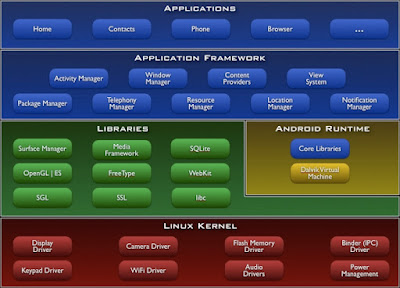In Android, Architecture mainly we have 4 blocks
1)Applications
2)Application Frameworks
3)Libraries
4)Linux Kernel
1)Applications :- It is user interaction part.user can use android applications by using this layer.
2)Application Frameworks:- By providing an open development platform, Android offers developers the ability to build extremely rich and innovative applications.Developer can take advantage of run back ground services location finder notifications can set alarms.
Activity manger:- It is helps to provide user interaction. we have a life cycle activity we will see at activity topic.
Window manager :- It is helps to give screen width and heights.
Content provider:- This manager is helpful to share the data between the applications.
View system:- It is used to building basic block for user interface components.
Package manger:- It is for retrieving various kinds of information related to the application packages that are currently installed on the device.
Telephony manager:- It provide telephone operations like call, sms etc,.
Resource manager:- To use external resources like images,xml files this manager is helpful.
Location manager:- This manager is useful in maps to find out the current location of the user.
Notification manger:- Used to notify the user of events that happen.
3)Libraries:- This layer consists of Android libraries written in C, C++, and used by various system. These libraries tells the device how to handle different kinds of data and are exposed to Android developers via Android Application framework.
surface manager:- It can combine the surfaces and gives a single view. it can combine 2D and 3D surface.
SQLite:- It is in built database for android.
Web kit:- In built browser for android.
Open GL|ES:- Android includes support for high performance 2D and 3D graphics with the Open Graphics Library (Open GL), specifically, the OpenGL ES API.
4)Linux Kernel:- It acts as an abstraction layer between the hardware and the rest of the software stack.




No comments:
Post a Comment